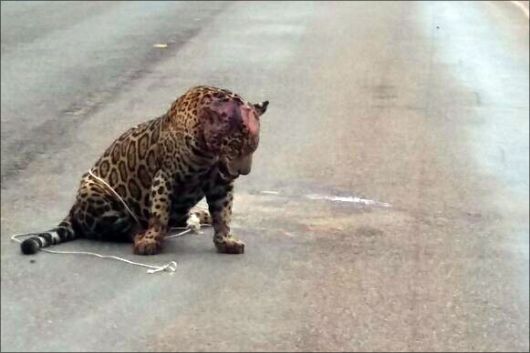
Uma onça-pintada macho pesando aproximadamente 120 quilos com cerca de 1,80 de comprimento foi atropelada nesta quarta-feira, 14, por volta das 13:30 por um veículo Gol, de cor vermelha, no trecho da rodovia entre Canavieiras e Santa Luzia, no extremo sul da Bahia. O bicho dever ter saído da reserva ambiental no município de Una.
O impacto foi tão forte que destruiu parcialmente a frente do carro. A onça ficou imobilizada no meio da estrada, sem poder andar. Curiosos que pararam para ver o animal de perto acharam que o mesmo teve uma das patas quebrada.
A onça-pintada está sendo ameaçada de extinção na Mata Atlântica. Segundo reportagem publicada na revista Scientific Reports - no estudo mais completo já divulgado sobre o assunto, menos de 300 desses felinos ainda sobrevivem no bioma, isolados em pequenas populações na América do Sul, nos países Brasil, Paraguai e Argentina.
A publicação mostra que quase 90% do habitat original das onças-pintadas já desapareceram. Apenas 7% das florestas que restam ainda estão em bom estado de conservação, com tamanho e alimento suficientes para abrigar a espécie. Não bastasse isso, os poucos animais que restam são perseguidos e mortos por caçadores e fazendeiros.
Os autores do trabalho informam que a Mata Atlântica corre risco de se tornar a primeira floresta no mundo a ter o seu maior predador extinto.
Versão Inglês.
A male jaguar weighing approximately 120 pounds and about 1.80 in length was struck on Wednesday, 14, around 13:30 by a red Gol vehicle on the stretch of highway between Canavieiras and Santa Luzia , In the extreme south of Bahia. The animal must have left the environmental reserve in the municipality of Una.
The impact was so strong that it partially destroyed the front of the car. The jaguar was stuck in the middle of the road, unable to walk. Curious people who stopped to see the animal closely thought they had one of their legs broken.
The jaguar is being threatened with extinction in the Atlantic Forest. According to a report published in the journal Scientific Reports, less than 300 of these felines still survive in the biome, isolated in small populations in South America, Brazil, Paraguay and Argentina.
The publication shows that almost 90% of the original habitat of jaguars has already disappeared. Only 7% of the remaining forests are still in good condition, with sufficient size and food to house the species. If that were not enough, the few remaining animals are hunted down and hunted down by hunters and farmers.
The authors report that the Atlantic Forest is at risk of becoming the first forest in the world to have its largest extinct predator.
.jpg)
.jpg)
.jpg)
 MICARETA / ITAGIMIRIM
MICARETA / ITAGIMIRIM 5º FESTIVAL DO CHOPP
5º FESTIVAL DO CHOPP.gif)